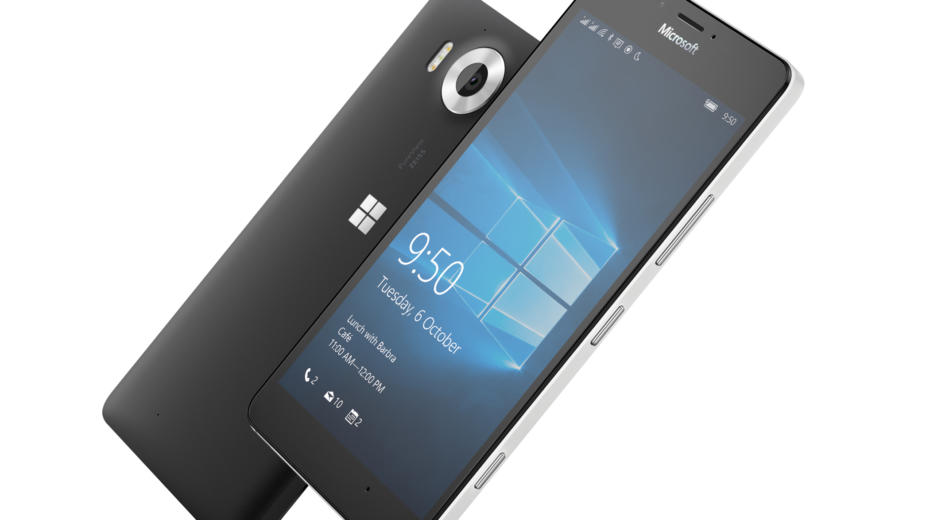The Lumia line of smart phones from Microsoft has shaken off the Nokia branding, but thankfully not the Nokia sensibilities.
The new Lumia 950 is a highly featured device that offers unique capabilities, as well as a few competitive offerings that lead in class. However, it has a few drawbacks that mean it amy only ever be of limited appeal.
First of all, the 950 is driven by six cores in the form of a dual-core 1.82 GHz Cortex-A57 and a quad-core 1.44 GHz Cortex-A53 on the MSM8992 Snapdragon 808 chipset. The 950 and its stablemate the 950XL are the first proper Windows Phone 10 devices, and need all that horsepower (with the XL sporting a further 2 cores) for the new OS.
That said, the interface is fluid and smooth, with the Windows Hello security feature working especially well. This feature uses an infrared iris scan for biometric security to unlock the device. Some reviewers reported low success rates, but in testing the 950 only ever asked for the device to be moved closer for success. It works about as well as the face unlock on Nexus devices tested.
Expandable
The 950 has 3GB of system RAM, with the tested model having 32GB of storage, expandable via a microSD card slot that can take up to 2TB card. This combined with a removable battery make the 950 something of a distinct offering in the high end smart phone market.
However, this flexibility seems to come at a cost insofar as the removable back lets the otherwise excellent construction of the 950 down a bit. The back is plastic and feels a bit cheap and cheerful next to the likes of the all metal chassis from other manufacturers, or the Gorilla glass finish of others.
The screen however, is a thing of beauty. The 132mm (5.2”) AMOLED capacitive touchscreen is vibrant, with deep, rich colours and at 564 ppi pixel density across its 1440 x 2560 resolution, one of the densest displays in its class.
The 950 running Windows Phone 10 has a nice feature in that the display can show notifications, such as time, date, alarm setting, email, social media alerts etc., in a very low power mode while the phone is locked, which is handy indeed. It means that you don’t need to waste time or battery life turning on to check for such things.
Familiar interface
The interface will be familiar to anyone from the Windows Mobile ‘Tango’ update onwards, or indeed, any Windows 10 users, which is the whole point of the universal app initiative from Microsoft. There is the usual customisation capabilities for tile placement, animation and sizing, as well as the pull down menu for notifications and settings. Among the other nice touches, especially for the polyglot, is the ability to change language by swiping the spacebar of the onscreen keyboard. Yet another, is the touchscreen equivalent of the old laptop keyboard ‘nipple’ to navigate around a text input, such as a text or tweet, to correct or edit.
Another distinctive feature is the use of the USB Type C connector for data and charging. While this is a break from the current micro USB standard, it is going to be the standard for smart connected devices (SCD) in the future, so is worth getting used to.
Of course, the Type C connector is what allows the 950 and the XL to do thing that really sets them apart. Not only do the Lumia pair sport full versions of the Office apps that make a Windows Phone one of the most productive SCDs, they can both, via either their dock accessory, or a compatible Miracast device, use their implementation of Windows Continuum to essentially become desktop devices.
The mobile dock is a free accessory with the 950XL, but must be requested, and allows a 950 or XL to be expanded with USB ports, HDMI and miniDisplayPort. This gives connectivity for an external keyboard and mouse, though Bluetooth can be employed for these too, but supports up to a full 1080p display for a monitor. The device can then be used like a desktop.
Microsoft envisage this as short term usage feature, where the SCD can act for a short period as a full desktop, or presentation device. The idea is that for the likes of a short business trip, or impromptu bit of work, the device can step up and do what a full PC does. Obviously this mode of operation has significant battery implications, but the dock charges as it operates, but in Miracast mode, better have the phone plugged in.
Some reviewers have complained of buggy operation in Continuum mode, but in our review, we did not encounter any issues, in an albeit short assessment.
Noteworthy features
There are numerous other features worth mentioning but a stand out is the camera. A three colour LED flash and high dynamic range capture allows the 20MP sensor, which is shared by the two devices, to achieve image quality normally reserved for the high-end, dedicated compact devices. The Carl Zeiss lens and very clever software, along with nice features such as dedicated camera button, make the camera among the best in the smart phone market currently.
In all, the Lumia pair of the 950 and 950XL offer a fairly unique combination of capabilities and features, in a reasonably attractive, but very easy to use package. But the Achilles heel is the application support.
For example, an increasingly common use of the smart phone is personal banking. Even on a work issued device, many users would be allowed use an official banking application. Alas, only Ulster Bank of the domestic crop has a dedicated Windows app available from the app store. Despite the ability of universal apps to allow developers to write once and deploy across multiple platforms — but critically, to appear uniformly on any Windows 10 device — there simply is not the diversity or support in the ecosystem, that currently exists for Android or iPhone. However, the browser experience and screen quality do allow many online services to be used in lieu of apps, but it is not quite the same thing.
The other thing is that for some more specialist interests of a personal nature… it is even worse. The reviewer’s predilection for motorsports and a suitable lap-timing apps drew a complete blank. That and the lack of vibrate only alarms were the deal breakers.
While experts are predicting that the future enterprise SCD landscape will be a three OS affair, at the moment, the consumer end of things still looks a two horse race. The new Lumia pair will sell well to anyone who has had a Windows Phone in the recent past, even better for someone looking for a Blackberry replacement and, furthermore, is likely to sell by the pallet in the corporate world. The manageability of Windows 10 devices makes them ideal in a fleet situation but, for consumers, without the app support, this strong and distinctive pair are unlikely to tempt them away.
The Lumias are available on Vodafone, Meteor and Three, starting from free up to €549 contract free.
microsoft.com/en-ie/mobile/phone/lumia950
TechCentral Reporters








Subscribers 0
Fans 0
Followers 0
Followers